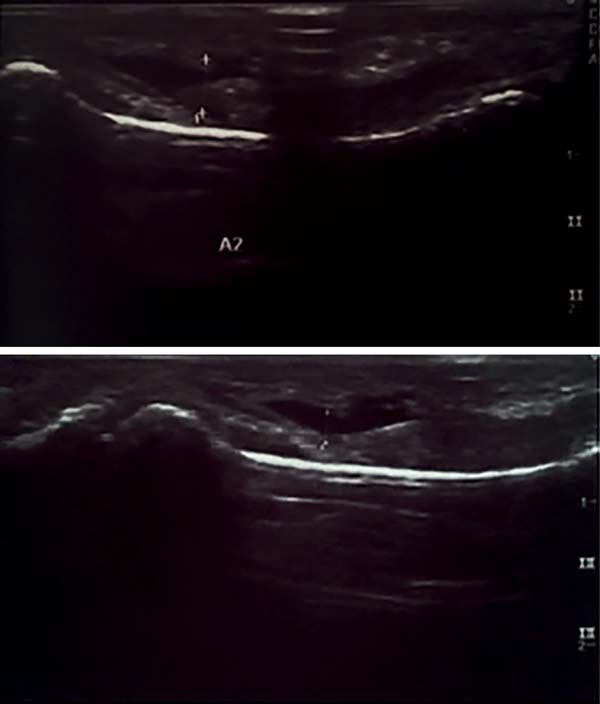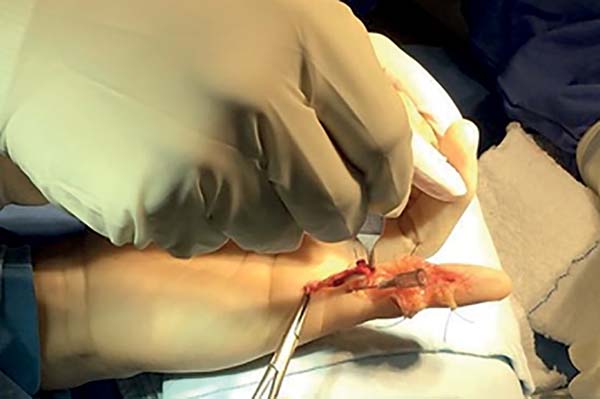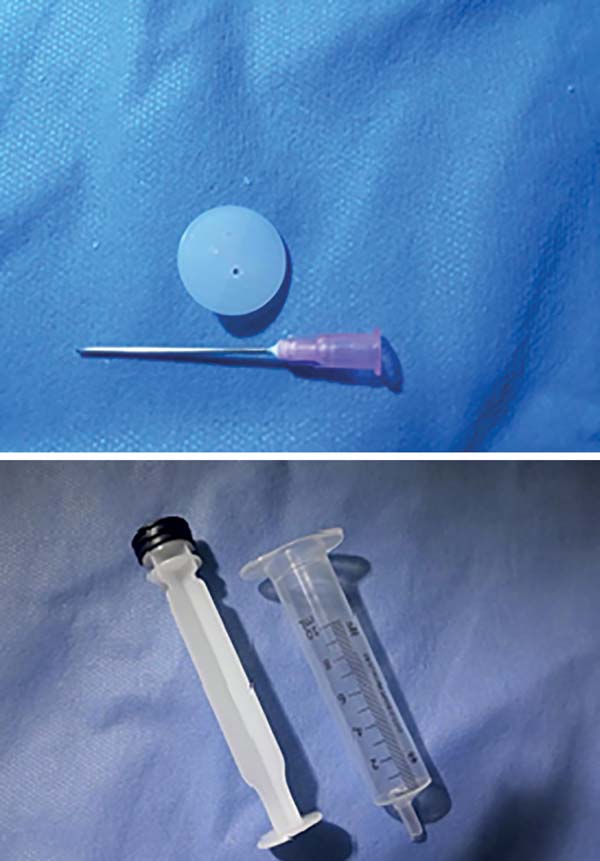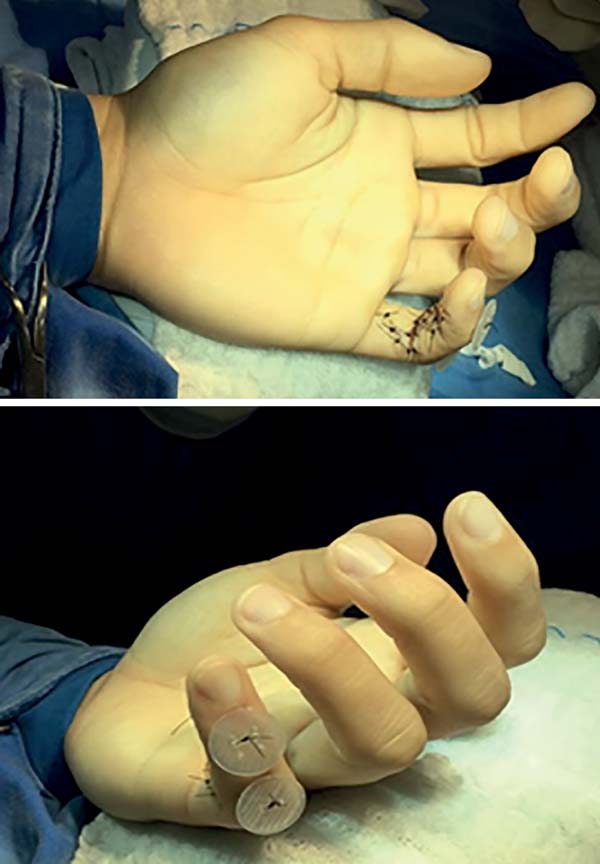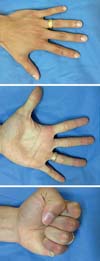INTRODUCTION
The flexor tendons are divided into five zones, as proposed by Verdan. Zone I
extends from the insertion of the superficial flexor tendon (also known as
flexor digitorum superficialis; FDS) to the insertion of the deep flexor tendon
(also known as flexor digitorum profundus; FDP), including pulleys C3 and
A51. Injuries in zone I only affect
the deep flexor tendon of the finger and are relatively common and prevalent
in
younger populations and athletes. The trauma is usually caused by closed
lacerations or avulsions, occurring more frequently in the fourth and fifth
fingers of the hand1,2.
Zone II consists of the region between pulley A1 and the beginning of zone I.
This zone includes the osteofibrous tunnel and Camper’s chiasm, known as
Bunnell’s no man’s land, due to the high risk of complications after tendon
injuries, such as adhesions and re-ruptures1.
The objective of this study is to describe the rare case of a patient who
suffered a traumatic avulsion of the superficial and deep flexor tendons of the
fifth finger, in zones 1 and 2 of Verdan, respectively, and was surgically
treated using the pull-out technique described by Bunnell3.
CASE REPORT
A 25-year-old man was admitted to the emergency room as a result of trauma on the
fifth finger of his left hand that occurred during a football match on the
previous day while trying to hold another player’s shirt. On physical
examination, he felt pain in the palmar area and presented edema and inability
to flex the proximal and distal interphalangeal joints of the fifth finger, with
no alterations of the neurovascular status.
Urgent radiographs were taken, confirming bone integrity. An ultrasound of the
finger showed total rupture of the superficial and deep flexor tendons of the
fifth finger with tendon retraction (Figure 1).
Figure 1 - Ultrasound images of the total rupture of the flexor tendons of
the fifth finger
Figure 1 - Ultrasound images of the total rupture of the flexor tendons of
the fifth finger
The surgery was performed with the patient under sedation, with brachial plexus
nerve block and ischemia of the left upper limb. The palmar area of the fifth
finger was accessed through a Brunner’s Z-type incision and complete
disinsertion of the superficial and deep flexor tendons was observed (Figure 2). After repairing the tendon stumps
with a Krackow suture with Nylon 4-0, bone tunnels were made in the middle and
distal phalanges with a 1.0-mm K-wire.
Figure 2 - Complete and simultaneous rupture of the flexor tendons of the
fifth finger.
Figure 2 - Complete and simultaneous rupture of the flexor tendons of the
fifth finger.
Using a hypodermic needle 40 x 12, the repair wires of the tendon stumps were
crossed to the dorsal region of the phalanges, which were fixed to their
respective insertion regions using the pull-out technique with the aid of
“knobs” made with the base of a 10 mL syringe (Figure 3). Lastly, pulleys A3 and A5 were repaired. A dressing was
applied after suturing, followed by immobilization with a dorsal splint with
10º
of wrist extension and 90º flexion of the metacarpophalangeal joints (Figure 4).
Figure 3 - Buttons made with syringe and hypodermic needle.
Figure 3 - Buttons made with syringe and hypodermic needle.
Figure 4 - Intraoperative outcome after reinsertion of the tendons using the
pull-out techniquea.
Figure 4 - Intraoperative outcome after reinsertion of the tendons using the
pull-out techniquea.
The protocol described by Duran was followed and dorsal immobilization was
maintained for six weeks, with changes every 15 days and progressive extension
of the splint. During the 6th week, the immobilization was removed
and physical therapy with a hand therapist was started.
One year postoperatively, the patient was asymptomatic, the scars had improved
appearance, and there were no tendon adhesions. The sensitivity remained
unchanged and the functional range of motion of the finger joints were as
follows: proximal interphalangeal joint (PIPJ) 10-90º, distal interphalangeal
joint (DIPJ) 10-85º, metacarpophalangeal joint (MCPJ) 0-90º (Figure 5). This result is considered good by
the scale of the American Society for Surgery of the Hand (ADM > 75%) and
excellent by the Strickland’s adjusted scale4.
Figure 5 - Postoperative clinical evaluation
Figure 5 - Postoperative clinical evaluation
DISCUSSION
Avulsion injuries of the deep flexor tendon at its insertion at the base of the
distal phalanx of the fingers is common, especially in athletes and men, with
a
prevalence for the ring finger that accounts for 75% of these lesions5. Conversely, injuries in the superficial
flexor tendon of the fingers are uncommon and mainly affect the ring or middle
finger5. A closed lesion of both
tendons is rare and only nine cases have been described in the literature since
19846.
Of those cases, all patients were men, with ages ranging from 16 to 49 years
(mean of 26.9 years). There were seven cases with one affected finger (ring
finger in four cases, middle finger in one case, little finger in two cases),
one case with two affected fingers (ring and little fingers) and one case with
three affected fingers (index, middle and ring fingers)6. In our case, in agreement with the small epidemiology
available in the literature, the patient was male, young (25 years old) and only
the little finger was affected.
Regarding the mechanism of trauma, the most common, which occurred in three of
the nine patients with injuries in both tendons, was the Jersey finger (term
created to denote the closed lesion of the deep flexor tendon at its insertion
at the distal phalanx of the finger as it is common among American football and
rugby players when trying to hold the opponent’s shirt or jersey)6. The same was reported by our patient who
was injured during a football match.
Direct trauma occurred in one case, as did repetitive microtrauma.
Traction-hyperextension occurred in two cases. In all cases, except for one,
the
injury of the FDS occurred in zone 26. In
the study by Soro et al.6, the rupture
occurred in zone 3. Regarding the FDP, the tendon was affected in zone 2 in two
cases and in zone 1 in all other cases.
Radiographs of the affected finger should always be requested to evaluate the
presence of fractures in the phalanges. Imaging tests, such as ultrasound and
magnetic resonance imaging (MRI), help diagnose where the tendons have been
damaged, facilitate the surgical approach, and prevent exploration to locate
the
ruptured tendon stump1,2,5.
In the present case, the radiographs of the little finger discarded the presence
of fractures and the ultrasound helped us to diagnose the simultaneous rupture
of the tendons and allowed us to properly plan the surgery. Of the previous
reports, only Toussaint et al.7 used
preoperative ultrasound as a tool for diagnosis, facilitating the surgical
procedure performed.
Several techniques have been described in the literature to repair flexor
tendons, but a consensus on the best approach to reinsert the tendon does not
exist. Some studies have reported that the pull-out technique is associated with
a great number of complications. Kang et al.8 reported a 22% infection rate and abnormal nail growth in 35% of
patients.
In fact, a button can hinder personal hygiene, get stuck in clothes, and cause
pain and necrosis in the skin via the pressure and injury of the nail bed if
it
is fixed very proximally at the reinsertion of the FDP. In our case, the patient
underwent surgery two days after the injury and the technique was performed
according to the description of Bunnell3
in both flexor tendons of the fifth finger, with the patient progressing without
complications until the buttons were removed.
Of the cases described with the simultaneous injury, the pull-out reconstruction
was performed in five of the six cases operated acutely, but the FDS was
resected in two cases. In one acute case, the repair was performed in two
stages, with excision of the tendons in the first stage and the use of the graft
of the long palmar as graft for reconstruction after nine weeks.
The surgery was performed between 0-4 days for all patients treated acutely. In
two cases, the reconstruction was performed sub-acutely, with the surgery taking
place 14 and 20 days after the injury. In the first case, the end-to-end repair
of the FDP and resection of the FDS were performed. In the other case, the
two-stage repair with the long palmar graft was used. In the only case treated
chronically, four weeks after the injury, a long palmar graft was used for
reconstruction6.
In seven of the nine cases described, the authors stated that their patients
returned to work, with good function of the injured fingers, even in late tendon
reconstructions, in two stages. In eight cases, the authors cited some stiffness
or limited mobility of the distal interphalangeal joint, without significant
functional impairment of the finger.
The result was described as good or excellent in five of the cases. In four
cases, the authors have the opinion that the result was not good because the
injury of the FDP occurred in zone 2 or due to dilaceration in zone 16. Our patient, despite the partial loss of
flexion of the DIPJ, evolved with a complete return to his military activities
without limitations.
Since various surgical techniques were used in the cases previously described,
there is no consensus on the best approach to treat the injury. We believe that
the most anatomical reconstruction possible, with the repair of the two damaged
tendons, allows a better functional result. In agreement with our opinion, in
three of the published cases, the FDS and FDP were reinserted with excellent
functional results and minimal loss of movement6.
Evaluating the three cases in which the FDS was resected, our treatment option is
confirmed. One evolved with rigidity of the DIPJ and PIPJ; another remained with
limited range of motion in all operated finger joints (MCPJ, PIPJ and DIPJ);
and
the third case, which included two injured fingers, evolved with limited
movement and residual flexion in the interphalangeal joints of both fingers
(DIPJ 15º, PIPJ 10º in the ring finger and DIPJ 10º and PIPJ 40º in the little
finger). Thus, we defend that treatment a few days after the injury, absence
of
fractures, pull-out technique, and a physiotherapeutic program favored the
result, even in zone 2.
The injury of the deep flexor tendon was firstly classified by Leddy and Packer
into three types based on the level of retraction of the proximal stump and the
presence and size of the avulsed bone fragment9. Subsequently, new subtypes were added to the original
classification (types 4, 5A, 5B, and 5C). Recently, Azeem et al.10 created a more comprehensive
classification (Chart 1) to facilitate
the understanding of the injury pattern, and thus, provide the most appropriate
treatment for a better outcome.
Chart 1 - Classification of Azeem
10.
| Type I |
Isolated avulsion of the FDP tendon without
fracture of the distal phalanx
|
| Type Ia |
Avulsion of the tendon and retraction up to the
PIPJ
|
| Type Ib |
Avulsion of the tendon with a minimum bone fragment
that prevents retraction of the tendon up to the palm of the
hand
|
| Type Ic |
Avulsion of the tendon and retraction up to the
palm of the hand
|
| Types II and III |
Avulsion associated with fracture of the distal
phalanx
|
| Type IIa |
Avulsed tendon adhered to a single bone fragment of
the distal phalanx, extra-articular
|
| Type IIb |
Avulsed tendon adhered to a single bone fragment of
the distal phalanx, intra-articular
|
| Type IIc |
Avulsed tendon adhered to a bone fragment of the
distal phalanx, intra or extra-articular, with dorsal cortical
fracture
|
| Type III |
Similar to type II, but with secondary retraction
of the tendon of the avulsed bone fragment, adhered or not to
another bone fragment
|
| Type IIIa |
Incarcerated tendon on pulley A4 |
| Type IIIb |
Retraction of the tendon up to the palm of the
hand
|
| Type IIIc |
Fracture of the distal phalanx with joint
involvement
|
| Type IIId |
Fracture of the distal phalanx with dorsal cortical
involvement
|
Chart 1 - Classification of Azeem
10.
These authors state that their classification is more comprehensive and includes
all injury patterns of the flexor tendons. However, the injury described in our
case with avulsion of the FDP associated with the FDS is not present in Azeem’s
classification10. We believe that the
combined injury of the flexor tendons could be included as a new subtype of this
classification.
CONCLUSION
Simultaneous avulsion via closed trauma of the superficial and deep flexor
tendons of the fingers is rare and only nine cases have been described in the
literature. Despite the good results presented previously, different techniques
were used by each author; thus, it is not possible to define the best approach
to treat the injury. In this case report, the pull-out technique, originally
described by Bunnell, associated with a specific protocol, provided adequate
fixation of both tendons, with low cost, and an excellent functional result.
COLLABORATIONS
|
HM
|
Analysis and/or interpretation of data, data collection, design of
the study, project management, research, methodology, performing
surgeries and/or experiments, writing - preparation of the original,
writing - review and editing.
|
|
CG
|
Final approval of the manuscript.
|
|
IC
|
Final approval of the manuscript.
|
|
JLD
|
Final approval of the manuscript.
|
REFERENCES
1. Azar FM, Canale ST, Beaty JH. Campbell's Operative Orthopaedics.
13th ed. Philadelphia: Elsevier/Mosby; 2016.
2. Green DP, Hotchkiss R, Pederson W, eds. Green's Operative Hand
Surgery. 7th ed. New York: Churchill Livingstone; 1999. p. 1877,
81.
3. Bunnell S. Primary repair of severed tendons: the use of stainless
steel wire. Am J Surg. 1940;47(2):502-16.
4. Libberecht K, Lafaire C, Van Hee R. Evaluation and functional
assessment of flexor tendon repair in the hand. Acta Chir Belg.
2006;106(5):560-5.
5. Netscher DT, Badal JJ. Closed flexor tendon ruptures. J Hand Surg
Am. 2014;39(11):2315-23.
6. Soro MA, Christen T, Durand S. Unusual Closed Traumatic Avulsion of
Both Flexor Tendons in Zones 1 and 3 of the Little Finger. Case Rep Orthop.
2016;2016:6837298. DOI: http://dx.doi.org/10.1155/2016/6837298
7. Toussaint B, Lenoble E, Roche O, Iskandar C, Dossa J, Allieu Y.
Subcutaneous avulsion of the flexor digitorum profundus and flexor digitorum
superficialis tendons of the ring and little fingers caused by blast injury.
Ann
Chir Main Memb Super. 1990;9(3):232-5.
8. Kang N, Pratt A, Burr N. Miniplate fixation for avulsion injuries of
the flexor digitorum profundus insertion. J Hand Surg Br.
2003;28(4):363-8.
9. Leddy JP. Avulsions of the flexor digitorum profundus. Hand Clin.
1985;1(1):77-83.
10. Azeem MA, Marwan Y, Morshidy AE, Esmaeel A, Zakaria Y. A New
Classification Scheme for Closed Avulsion Injuries of the Flexor Digitorum
Profundus Tendon. J Hand Surg Asian Pac Vol. 2017;22(1):46-52.
1. Hospital da Força Aérea de Brasília, Brasília,
DF, Brazil.
2. Universidade de Brasília, Brasília, DF,
Brazil.
3. Hospital Naval Marcílio Dias, Ortopedia, Rio de
Janeiro, RJ, Brazil.
4. Instituto Nacional de Traumatologia e
Ortopedia, Rio de Janeiro, RJ, Brazil.
Corresponding author: Henrique Mansur, Área Militar do Aeroporto
Internacional de Brasília - Lago Sul - Brasília, DF, Brazil, Zip Code 71607-900.
E-mail: henrimansur@globo.com, henrimansur@globo.com
Article received: April 3, 2018.
Article accepted: October 1, 2018.
Conflicts of interest: none.


